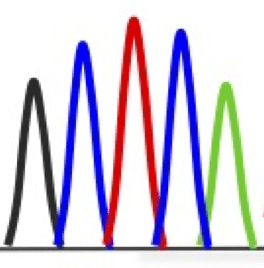Classical Ehlers-Danlos syndrome (cEDS)
Gene: COL5A1
Transmission: Autosomal, dominant
The animal only has to have one copy of the mutation to be at risk of developing hypertrophic cardiomyopathy. Animals with two copies of the mutation generally have more severe symptoms and an earlier onset of the disease than animals with just one copy of the mutation. Offspring are potentially at risk of developing the disease if at least one parent carries the mutation. Alternatively, the disease is caused by a de novo mutation.
Mutations:
Domestic shorthair mutation: Deletion, COL5A1 gene; c.3420del.G, p.(Leu1141Ser frame shift STOP 134), exon43.
Domestic shorthair mutation: Deletion, COL5A1 gene; c.3066del, p.(Gly1023Val frameshift STOP 50)
Domestic medium-haired mutation: Splicing error, COL5A1 gene; c.501-2A>C deletion, exon4.
Bombay mutation: Substitution (nonsense), COL5A1 gene; c.3514A>T, c.(Lys1172 STOP)
Bengal mutation: Deletion, COL5A1 gene; c.112_118+15 deletion.
Maine Coon mutation: Large genomic deletion, COL5A1gene; 33,740bp deletion including last two exons of COL5A1 gene.
Breeds: Bengal, Bombay, Domestic Cat, Domestic Shorthair, Maine Coon
Medical system: Dermal disorder, skeletal disorder
Age of onset of symptoms: At birth or within a few months.
Classical Ehlers-Danlos Syndrome (cEDS) is a rare inherited disorder affecting connective tissues due to abnormal collagen protein production. The “classical” designation refers to the disease when caused by mutations within the COL5A1 gene, which codes for a collagen protein that gives structure to extracellular tissues. Cats affected by cEDS have fragile, hyperextensible skin that is prone to tearing after minimal trauma, delayed wound healing, and excessive scarring. Other clinical signs include joint hypermobility which makes affected cats more prone to dislocations and orthopedic problems. Ocular anomalies, such as corneal ulcers, may also be present. Affected cats can have a characteristic “tragic facial expression” due to loose and sagging skin around the face. Several independent and de novo mutations in the COL5A1 gene have been identified, in both domestic cat populations and in several purebred cat breeds. While Ehler-Danlos Syndrome has no cure, proper management can help maintain a reasonable quality of life for an affected animal. Since the disease displays dominant transmission and since affected animals are identified early in life and would not be considered good candidates for reproduction, the disease is not generally of concern to the breeds in question.
References:
OMIA link: [2165-9685]
Rietmann SJ, Nowell S, Keating MK, et al. (2024) Heterozygous COL5A1 deletion in a cat with classical Ehlers-Danlos syndrome. Anim Genet 55:705-707. [pm/38745376]
McElroy A, Gray-Edwards H, Coghill LM, Lyons LA. (2023) Precision medicine using whole genome sequencing in a cat identifies a novel COL5A1 variant for classical Ehlers-Danlos syndrome. J Vet Intern Med 37:1716-1724. [pm/37594181]
Kiener S, Apostolopoulos N, Schissler J, et al. (2022) Independent COL5A1 variants in cats with Ehlers-Danlos syndrome. Genes (Basel) 13:797. [pm/35627182]
Spycher M, Bauer A, Jagannathan V, et al. (2018) A frameshift variant in the COL5A1 gene in a cat with Ehlers-Danlos syndrome. Anim Genet 49:641-644. [pm/30246406]
Contributed by: Emily Choi and Soo Yeon Park, Class of 2029, Faculté de médecine vétérinaire, Université de Montréal.

